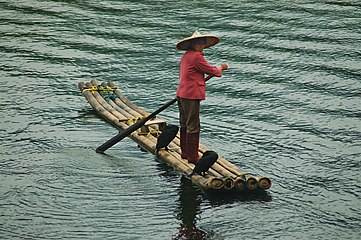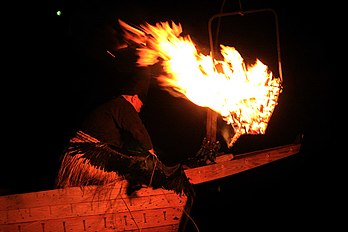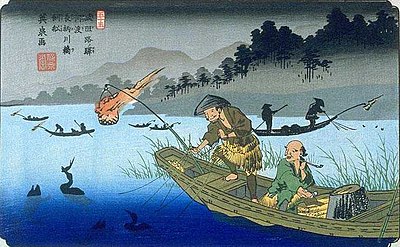Cormorant fishing
Cormorant fishing is a traditional
To control the birds, the fishermen tie a loose
The types of cormorants used differ based on the location. Chinese fishermen typically employ the great cormorant (Phalacrocorax carbo),[5] while the Japanese cormorant (Phalacrocorax capillatus) is used in Japan and the neotropic cormorant (Nannopterum brasilianum) in Peru. Darters (birds in the genus Anhinga), which are relatives of cormorants, are also used for this fishing technique on occasion.
China
In
-
Great cormorants are typically used by Chinese fishers
-
Chinese fisherman with his cormorants
-
Chinese fisherman with one of his cormorants onDali, Yunnan. The bird's throat snare is visible via the constriction in the bird's neck.
-
Chinese cormorant fisherman traditionally use bamboo boats
-
Fishing with cormorants in China, circa 1894
-
Contemporary fishing with cormorants on Poyang Lake, China
Japan
Cormorant fishing in Japan is called ukai (鵜飼) in Japanese. Originally, it was done as one of the main fishing methods for ayu (sweetfish) fishing.[7] However, since it is "unique" (as it uses birds and skillful techniques), viewing cormorant fishing, since the Heian period, has been one of amusements for aristocratic classes and warlords in Japan.[7]
-
Japanese cormorants are typically used by Japanese fishers.
-
Japanese cormorant trained by its master in Japan
-
Cormorant fishing master on a boat at night in Gifu, Japan
-
Keisai Eisen's print of cormorant fishing on the Nagara River during the Edo period
-
Viewing of cormorant fishing as an amusement (a woodblock print of Utagawa Kunisada, 1852)
Oda Nobunaga started showing cormorant fishing for hospitality in Japan.[8] In 1568, Oda Nobunaga, welcoming a messenger from Takeda Shingen, made a new boat and invited the messenger as a guest to show cormorant fishing.[8] In addition, he chose ayu (sweetfish) with his own eyes and sent it to the guest as a gift at a later date.[8] Tokugawa Ieyasu, after the Summer Campaign (1615) of Siege of Osaka, visited Gifu, enjoyed seeing cormorant fishing and eating ayu.[8] Thus began to offer ayu sushi to the Shogun, and masters of cormorant fishing were allowed to move freely over the river.[8]
Cormorant fishing currently takes place in 13 cities in Japan. The most famous location is Gifu, Gifu Prefecture, home to cormorant fishing on the Nagara River, which has continued uninterrupted for the past 1,300 years.[9] Cormorant fishing in Seki also takes place on the Nagara River, but it is called 'Oze cormorant fishing' (小瀬鵜飼 Oze Ukai). Only the cormorant fishing masters in Gifu and Seki are employed by the emperor and called Imperial Fishermen of the Imperial Household Agency.
- Fuefuki, Yamanashi Prefecture (Fuefuki River)
- Gifu, Gifu Prefecture (Nagara River)
- Seki, Gifu Prefecture (Nagara River)
- Inuyama, Aichi Prefecture (Kiso River)
- Uji River)
- Kyoto, Kyoto Prefecture (Ōi River)
- Arida, Wakayama Prefecture (Arida River)
- Miyoshi, Hiroshima Prefecture (Basen River)
- Masuda, Shimane Prefecture (Takatsu River)
- Iwakuni, Yamaguchi Prefecture (Nishiki River)
- Ōzu, Ehime Prefecture (Hiji River)
- Hita, Ōita Prefecture (Mikuma River)
- Asakura, Fukuoka Prefecture (Chikugo River)
Peru

Cormorants are used for fishing on Lake Titicaca by the Uru people in Peru. There are claims cormorant fishing occurred in Peru during the 5th century, 100 years earlier than Japan.[10]
-
The neotropic cormorant is used for fishing in Peru
Europe
Cormorant fishing is an old tradition in Greece and North Macedonia,[11] especially on Doiran Lake which lies in the border of the two countries, and it is still practiced today by some traditional fishermen. In Western Europe, cormorant fishing took place from the 16th to 17th centuries, primarily in England and France.[12] In the 19th century, Francis Henry Salvin reintroduced the practice in England by putting on displays and bringing his birds to fisheries exhibitions.[13] This "second phase" of English cormorant fishing lasted until about 1890.[14]
See also
References
- .
- S2CID 162736384.
- ISBN 0-370-31060-8.
- ^ a b "Heart of the Dragon: Cormorant fishing". Wild China. BBC Two. Retrieved 2020-08-16.
- ^ "Cormorant Fishing "UKAI"". May 2001. Archived from the original on 2009-01-09. Retrieved 2008-01-30.
- ^ Larson-Wang, Jessica. "The History Behind the Cormorant Fishermen of Erhai Lake". Culture Trip. Archived from the original on 2020-08-16. Retrieved 2019-08-17.
- ^ . Retrieved 17 September 2022.
- ^ a b c d e "ぎふ長良川の鵜飼公式サイト「1300年以上の歴史と伝統」" [Over 1300 Years of History and Tradition]. ukai-gifucity.jp (in Japanese). Gifu-Ukai. Retrieved 2022-09-14.
- ^ "Gifu Cormorant Fishing on the Nagara River". ukai-gifucity.jp. Gifu City Cormorant Fishing Observation Boat Office. Archived from the original on 2020-08-16.
- ^ Leicht, Hermann (1960). Pre-Inca Art and Culture. New York: Orion Press. pp. 49–50.
- ^ "Macedonian cities - Dojran". macedonia.co.uk. Macedonian Cultural and Information Centre. Archived from the original on 2020-06-14.
- ^ Beike, Marcus (2014). "The history of Cormorant fishing in Europe" (PDF). Vogelwelt. 133: 1–21. Archived (PDF) from the original on 2020-08-16.
- ISBN 978-1-5267-0157-2.
- ^ Beike, Marcus (2012). "The history of Cormorant fishing in Europe" (PDF). Vogelwelt: 1–19.














